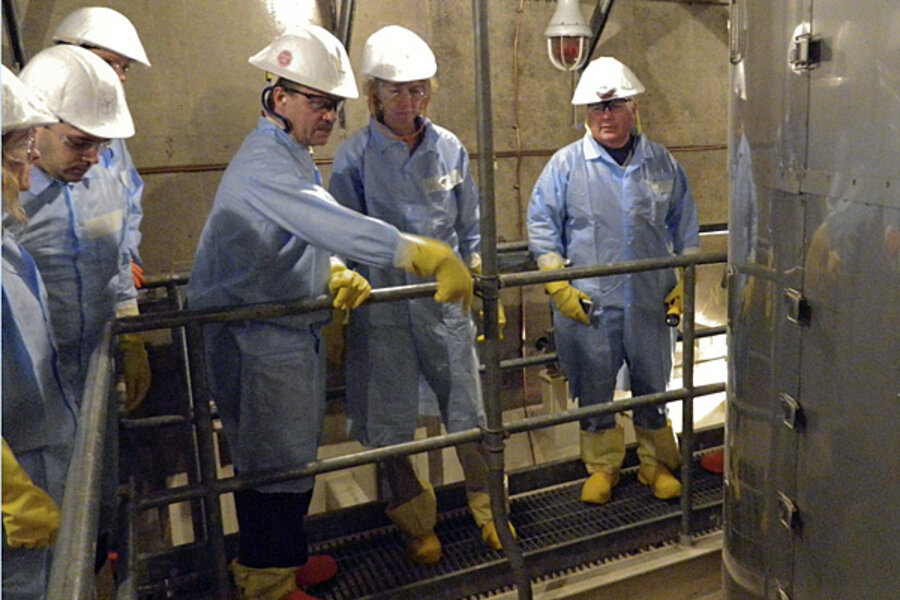Fukushima two years later: How safe are US nuclear plants?
Loading...
The 2011 Fukushima nuclear disaster left some Americans wondering: Could such a destructive failure happen to a nuclear plant in the US?
Two years later, US officials say the country's nuclear plants are safe, but a new report from an environmental organization challenges that assertion.
The Union of Concerned Scientists (UCS) found safety equipment problems and security shortcomings in a dozen nuclear plants across the country, according to a report the group released last week. While none of the issues resulted in injury to plant workers or the public, UCS says the frequency of the incidents are the result of lapses by the US Nuclear Regulatory Commission (NRC), the agency charged with overseeing the nuclear industry.
“It’s evident the NRC is capable of being an effective watchdog,” Dave Lochbaum, director of UCS’s Nuclear Safety Project and author of the report, said in a statement. “But too often the agency does not live up to its potential, and we are still finding significant problems at nuclear plants that could trigger a serious accident.”
The nuclear industry disagrees. Steven Kerekes, a spokesman for the Washington-based Nuclear Energy Institute, said the UCS uses a misleading metric to measure safety issues. The NRC, by contrast, counts two significant, "abnormal occurrences" at US nuclear plants over the past decade as its benchmark, he said.
"Our facilities are operating safely," Mr. Kerekes wrote in an e-mail. "We continue to aggressively implement additional safety enhancements based on [lessons] from the Fukushima accident to ensure that our plants will operate safely and reliably."
Last week, the NRC issued its annual report card finding that 99 of the country's 104 operating commercial nuclear power plants were in the two highest performance categories. Three plants were found to have a degraded level of performance, requiring additional oversight. The NRC found a safety issue of "high significance" in a plant in Alabama. One plant in Nebraska is in extended shutdown with significant performance issues.
The San Onofre Nuclear Generating Station in California has been shut down since 2012 due to the discovery of damaged tubes that transport radioactive water.
Nuclear plants in the US are safer than they have ever been before, said John Lee, professor of nuclear engineering at the University of Michigan. After 9/11, regulations were introduced to ensure a plant would not lose critical cooling functions in the case of a terrorist attack or other outage, Mr. Lee said.
The Fukushima disaster resulted in additional safety measures. The NRC required plants to install additional backup generators and assess the threat of floods and seismic activities.
Unlike Japan, the US nuclear regulatory agency is separate from the governmental research arm, said Ronald Gilgenbach, chair and professor of nuclear engineering at the University of Michigan. That division means there's less of a chance of conflict of interest, he added.
"Japan is now moving towards the model of the NRC in order to have a truly indpendent safety regulatory body," Mr. Gilgenbach said in a telephone interview.
For UCS, the improvements at NRC are notable, but lacking. Nearly half of NRC employees expressed skepticism that the agency is serious about addressing safety, according to a 2012 study by UCS. Between 2010 and 2012, nearly 40 percent of the nuclear fleet experienced conditions that increased their likelihood of reactor core damage by at least a factor of 10, the UCS report found.
Testifying before Congress last month, Allison Macfarlane, chairman of the NRC, said the agency is operating very well.
"The accident at the Fukushima Dai-ichi nuclear power plant continues to serve as a reminder that the NRC and industry must be prepared to address reasonably foreseeable events that could lead to severe accidents," Ms. Macfarlane wrote in her testimony. "We continue to work applying lessons from the accident to our regulation of NRC-licensed nuclear facilities. The NRC will take every reasonable precaution to prevent such an accident from happening here in the United States."






